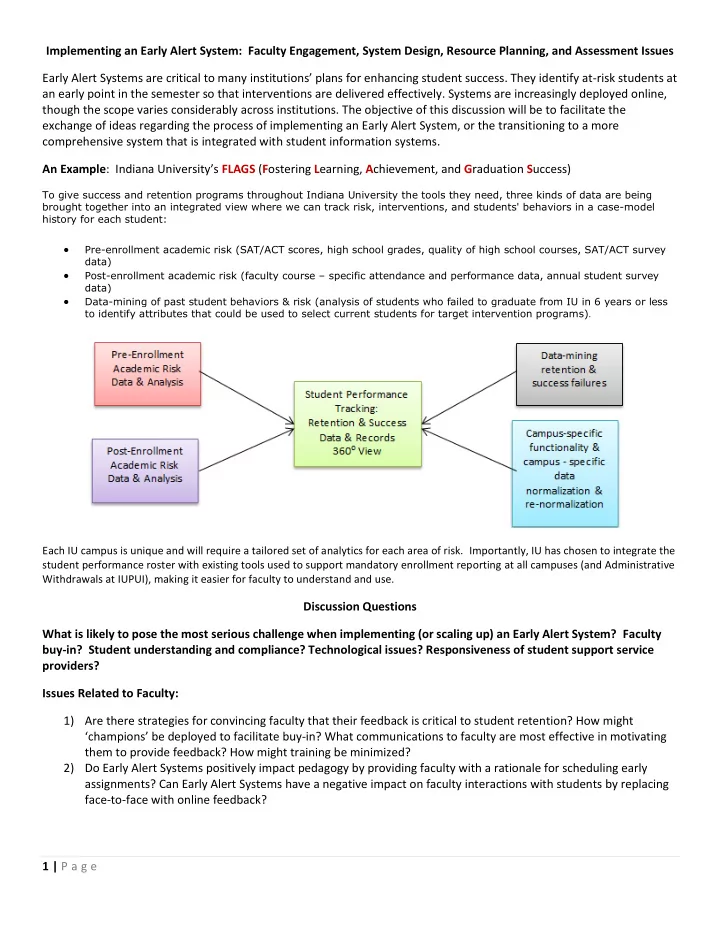

Implementing an Early Alert System: Faculty Engagement, System Design, Resource Planning, and Assessment Issues Early Alert Systems are critical to many institutions’ plans for enhancing student success. They identify at -risk students at an early point in the semester so that interventions are delivered effectively. Systems are increasingly deployed online, though the scope varies considerably across institutions. The objective of this discussion will be to facilitate the exchange of ideas regarding the process of implementing an Early Alert System, or the transitioning to a more comprehensive system that is integrated with student information systems. An Example : Indiana University ’s FLAGS ( F ostering L earning, A chievement, and G raduation S uccess) To give success and retention programs throughout Indiana University the tools they need, three kinds of data are being brought together into an integrated view where we can track risk, interventions, and students' behaviors in a case-model history for each student: Pre-enrollment academic risk (SAT/ACT scores, high school grades, quality of high school courses, SAT/ACT survey data) Post-enrollment academic risk (faculty course – specific attendance and performance data, annual student survey data) Data-mining of past student behaviors & risk (analysis of students who failed to graduate from IU in 6 years or less to identify attributes that could be used to select current students for target intervention programs) . Each IU campus is unique and will require a tailored set of analytics for each area of risk. Importantly, IU has chosen to integrate the student performance roster with existing tools used to support mandatory enrollment reporting at all campuses (and Administrative Withdrawals at IUPUI), making it easier for faculty to understand and use. Discussion Questions What is likely to pose the most serious challenge when implementing (or scaling up) an Early Alert System? Faculty buy-in? Student understanding and compliance? Technological issues? Responsiveness of student support service providers? Issues Related to Faculty: 1) Are there strategies for convincing faculty that their feedback is critical to student retention? How might ‘champions’ be deployed to facilitate buy -in? What communications to faculty are most effective in motivating them to provide feedback? How might training be minimized? 2) Do Early Alert Systems positively impact pedagogy by providing faculty with a rationale for scheduling early assignments? Can Early Alert Systems have a negative impact on faculty interactions with students by replacing face-to-face with online feedback? 1 | P a g e
Issues Related to Administration and Resources: 1) How might an Early Alert System be best piloted? Should Early Alert Systems be integrated with other forms of enrollment reporting or administrative withdrawal procedures? 2) When is the ideal point in time for Early Alert Systems to be turned on and off, and how frequently should faculty be encouraged to provide feedback? 3) How might courses be targeted so that all at-risk students can be monitored? Within a university, how might system design and training accommodate a wide range of schools or campuses? 4) How might student support services be expanded to meet the increased demand an Early Alert System creates? Is it better to intrusively engage with students or to cultivate an expectation that students will self-monitor their own performance feedback? Issues Related to Assessment and Evaluation: 1) What processes and outcomes should be assessed and used as indicators of Early-Alert program effectiveness? 2) What types of reports should be made available and to which audiences? Should data be made available to deans to encourage faculty participation and/or to guide the development of interventions to address risk factors? 3) How might Early Alert Systems be used to examine trends in student persistence or graduation rates over time? Assessing Early Alert Systems requires careful conceptualization of the processes and intended outcomes before choosing indicators of effectiveness and evaluation designs. Assessment scholars have advocated for the development of assessment plans with clear purposes closely aligned with program goals (e.g., Swing, 2001; Banta 2002). On many campuses early alert systems have been to improve student retention, academic performance and positive student- faculty interactions. Early Ale rt systems have also been characterized as a “High Impact Practice” due to their ability to provide 1) early intervention for address students’ needs proactively, 2) intrusive support, and 3) targeted support for students who need it most based on current behaviors (Cuseo, 2011). When developing a comprehensive assessment plan the best approach is to identity measures and indicators that assess the process of the system as well as intended outcomes. The following sections are adapted based on Cuseo (2011). Process Indicators - provide early feedback as to whether or not the Early Alert System has proceeded as intended, what barriers have been encountered, and what changes are needed. Most importantly, the process evaluations help to answer questions about why the intended outcomes were achieved or not achieved. Faculty members actively use the early alert system and make appropriate referrals to students who need them. Students are informed about the early alert system and read messages/notifications. Students make contact with the resource person identified in the early-alert message. Students report taking action on the recommendation or referral made by the resource person. Student perceptions from evaluations or campus surveys/questionnaires indicate that the early alert notification: enabled students to become aware of and self-modify the behavior that led to the notification (without seeking help from a campus resource), or motivated them to seek help from a campus resource, which, in turn, enabled them to modify the behavior that led to the notification. Outcome Indicators - used to assess The Early Alert System’s results, or outcomes, in a way that determines whether the system produced the changes in students, faculty, staff, advisors, administrators it intended to achieve. Retention rates Academic performance (DFW rates, grade point averages, satisfactory academic achievement) 2 | P a g e
Recommend
More recommend